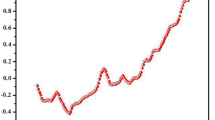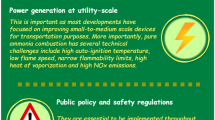Abstract
Pulsed positive corona discharges are used to remove NO from the flue gas of a methane burner. At low power input this leads to an increase in NO2, which shows that the process is oxidative. Removal efficiency is greatest when discharges are produced with high-voltage pulses, which are shorter in duration than the time required by the primary streamers to cross the discharge gap, in combination with a dc bias. Other important parameters are input power density and residence time. The best result obtained so far is an energy consumption of 20 eV per NO molecule removed, at 50% deNOx i.e., a removal of 150 ppm NOx, using a residence time of 15 s and an input power density, of 3.5 Wh/Nm3. [Wh/Nm3 stands for watt-hour per normal cubic meter, i.e., at normal conditions (273 K and 1 bar). This implies that 1 Nm3 contains 2.505 1025 molecules.] There appears to be room for improvement by the addition of gaseous and particulate chemicals or the use of multiple corona treatment. It is argued front comparison between results from models and experiments that the direct production of OH by the discharge is only the initiation of the cleaning process.
Similar content being viewed by others
References
H. Mätzing, “Chemical kinetics of flue gas cleaning by irradiation with electrons,” inAdvances in Chemical Physics, Vol. LXXX, ed. I. Prigogine, Wiley, New York (1991) pp. 315–359.
Y. L. M. Creyghton, “Pulsed positive corona discharges: fundamental study and application to flue gas treatment, Dissertation, Eindhoven University of Technology, September 1994.
N. W. Frank,Radiat. Phys. Chem. 40, 267–272 (1992).
D. Braun, U. Kuchler, and G. Pietsch,J. Phys. D: Appl. Phys. 24, 564–572 (1991).
K. J. McLean,IEE Proc. 135, 347–361 (1988).
S. Masuda, M. Hirano, and K. Akutsu,Radiat. Phys. Chem. 17, 223–228 (1981).
S. Masuda,Pure Appl. Chem. 60, 727–731 (1988).
N. Frank and S. Hirano, “The history of electron beam processing for environmental pollution control and work performed in the United States,” inNon-Thermal Plasma Techniques for Pollution Control, NATO Advanced Series Institute Series G,3413, eds. B. M. Penetrante and S. E. Schultheis, Springer, Heidelberg (1993), pp. 1–26.
L. Civitano and E. Sani “DeNOx-deSOx process by gas energization,” inPlasma Technology: Fundamentals and Applications, ed. M. Capitelli, Plenum, New York (1992), pp. 153–166.
R. H. Amirov, E. I. Asinovsky, L. I. Kropp, I. S. Samoilov., and A. M. Zykov, “Effect of fly ash removal of sulfur dioxide from flue gas utilizing nanosecond corona discharges,” in 10th Symposium on Elementary Processes and Chemical Reactions in Low-Temperature Plasma, ed. M. Morvova and P. Lukac, Comenius University, Bratislava (1994).
S. Masuda, “Report on novel dry DeNO x /DeSO x technology for cleaning combustion gases from utility thermal power plant boilers,” inNon-Thermal Plasma Techniques for Pollution Control, NATO Advanced Series Institute Series G,34B, eds. B. M. Penetrante and S. E. Schultheis, Springer, Heidelberg (1993), pp. 131–137.
E. M. van Veldhuizen, Y. L. M. Creyghton, and W. R. Rutgers, “Conversion of NO and SO2 by pulsed corona discharge,” in Book of Invitee Lectures of 10th Symposium on Elementary Processes and Chemical Reactions in Low-Temperature Plasma, eds. M. Morvova and P. Lukac, Comenius University, Bratislava (1994).
J. S. Clements, A. Mizuno, W. C. Finney, and R. H. Davis,IEEE Trans. Ind. Appl. 25, 62–69 (1989).
K. Yan, R. Li, M. Cui, L. Zhou, and H. Zhao, “Removal of NO x and SO2 by bipolar corona,” Proc. 4th Int. Conf. on Electrostat. Precip ed. Ruinian Li, Int. Ac. Publ Beijing (1991), pp. 635–649.
S. Masuda, Y. Wu, T. Urabe, Y. Ono, “Pulse corona induced plasma chemical process for DeNO x , DeSO x , and mercury vapour control of combustion gas,” Proc. 3rd Int. Conf. on Electrostat. Precip., ed. M. Rea, Abano-Padova, Italy, Masera di Padova: Tipolito (1987), pp. 667–676.
R. H. Amirov, E. I. Asinovski, I. S. Samoilov, and A. V. Shepelin,Plasma Sources Sci. Technol. 2, 289–295 (1993).
K. Fuji, “Simultaneous removal of NO x SO x and soot in diesel engine exhaust by plasma/oil dynamic means,” inPlasma Technology: Fundamentals and Applications, ed. M. Capitelli, Plenum, New York (1992), pp. 143–152.
B. M. Penetrante, G. E. Vogtlin, J. N. Bardsley, P. A. Vitello, and P. H. Wallman, “Application of non-thermal plasmas for pollution control,” Proc. 2nd Int. Plasma Symp. World Progress in Plasma Appl., Palo Alto, California, 1993, pp. 1–11.
N. Yu. Babaeva, A. A. Kulikovskiy, A. Kh. Mnatsakanian, G. V. Naidis, and Yu. M. Solozobov,Flue Gas Cleaning by Pulse Corona, Part I: The Streamer Propagation Models in N 2-O2 Mixtures and Flue Gas, IVTAN Analytical & Numerical Research Association, Moscow, Research Report IVTAN-ANRA #93/2, 1993, pp. 1–48.
G. Yu. Alekseev, A. V. Levchenko, and V. A. Bityurin,Flue Gas Cleaning by Pulse Corona, Part II: The Chemical Kinetics and Heat- and Mass Transfer in NO/SO 2 Removal, IVTAN Analytical & Numerical Research Association, Moscow, Research Report IVTAN-ANRA #93/2, 1993.
Y. L. M. Creyghton, W. R. Ruigers, and E. M. van Veldhuizen, “In-situ investigation of pulsed corona discharge,” Eindhoven University of Technology, EUT Report 93-E-279, 1993.
Y. L. M. Creyghton, E. M. van Veldhuizen and W. R. Rutgers,IEE Proc.-Sci. Meas. Technol. 141, 141–147 (1994).
M. Yousfi, A. Himoudi, and A. Gaouar,Phys. Rev. A 46, 7889–7901 (1992).
J.-M. Guo and C.-H.J. Wu,IEEE Trans. Plasma Sci. 21, 684–695 (1993).
G. A. Dawson and W. P. Winn,Z. Phys. 183, 159–171 (1964).
F. Bastien and E. Marode,J. Phys. D 12, 249–263 (1979).
A. J. Davies and C. J. Evans,Proc. IEE 114, 1547–50 (1967).
I. Gallimberti, Pure Appl. Chem.60, 663–674 (1988).
H. F. A. Verhaart,Kema Sci. Tech. Rep. 7, 377–383 (1989).
M. Yousfi, A. Poinsignon, and A. Hamani (1993), “Electron database needed for discharge modelling in flue gas treatment, inNon-Thermal Plasma Techniques for Pollution Control, NATO Advanced Series Institute Series G,34A, eds. B. M. Penetrante and S. E. Schultheis, Springer, Heidelberg 1993, pp. 299–330.
M. B. Zheleznyak, A. Kh. Mnasakanian, and S. V. Sizykh,High Temp. 20, 423–428 (1982).
N. Sato,J. Phys. D. 13, L3–6 (1980).
R. Morrow and L. E. Cram,J. Comput. Phys. 57, 129–138 (1985).
R. Morrow,J. Comput. Phys. 43, 1–15 (1981).
H. Mätzing, “Chemical Kinetics of Flue Gas Cleaning by Electron Beam,” Kernforschungszentrum Karlsruhe, Germany, Report KfK 4494, 1989.
J. C. Person, et al., “A unified projection of the performance and economics of radiation-initiated NO x /SO x emission control technologies,” U.S. Department of Energy, Pittsburgh Energy Technology Center, Pittsburgh, Pennsylvania 15236, Report No. PSI-TR-259/542, DE86 003620, 1985.
D. L. Baulch et al., CODATA Task Group on Chemical Kinetics, “Evaluated kinetic and photochemical data for atmospheric chemistry,”J. Phys. Chem. Ref. Data.9, 295–471 (1980);J. Phys. Chem. Ref. Data,11, 327–497 (1982);J. Phys. Chem. Ref. Data,13, 1259–1381 (1984).
Chemical Kinetics and Photochemical Data for Use in Stratospheric Modelling. Evaluation Number 9, Jet Propulsion Laboratory, California Institute of Technology, NASA, Pasadena, 1990.
K. Yan and E. M. van Veldhuizen,Flue Gas Cleaning by Pulse Corona Streamer, EUT Report 93-E-272, 1993.
E. V. Belousova et al.,Khim. Vys. Energ. (Eng. Transl.),25, 468–469 (1991).
P. Pirgov, “Electron energy distribution function and reaction rates for air and flue gas,” Eindhoven University of Technology, Internal Report EG/93/654, 1993.
K. Yan, E. M. van Veldhuizen, A. H. F. M. Baede, Y. L. M. Creyghton, and W. R. Rutgers, “Electron energy for primary and secondary streamers of pulsed corona in relation with flue gas cleaning,” Proc. 11th Int. Symp. on Plasma Chem., Loughborough, UK (1993 ), pp. 609–615.
O. Tokunaga, H. Namba, K. Hirota, “Experiments on chemical reactions in electronbeam-induced NO x /SO2 removal,” inNon-Thermal Plasma Techniques for Pollution Control, NATO Advanced Series Institute Series G,34B, eds. B. M. Penetrante and S. E. Schultheis, Springer, Heidelberg (1993), pp. 55–69; B. V. Potapkin, M. A. Deminsky, A. A. Fridman, and V. D. Rusanov, “The effect of clusters and heterogenous reactions on non-equilibrium plasma flue gas cleaning,”ibid., pp. 91–106 (1993). A. T. Kunavin, A. V. Markow, D. V. Sapozhnikov, and V. Y. Yakovlev, “Intensification of E-beam processing of SO2 removal from flue gas,”ibid., pp. 63–69 (1993).
S. Masuda, and H. Nakao,IEEE Trans. IAS 26, 374–383 (1990).
J. Mäkelä,Acta Polytech. Scand. Appl. Phys. Ser.No. 182, Helsinki (1992).
A. A. Lawrence, “Nitrogen oxides emission control,”Pollut. Control Rev., No. 90, Noyes Data Corp (1972).
N. W. Frank, “Economics of the electron beam process,” inNon-Thermal Plasma Techniques for Pollution Control, NATO Advanced Series Institute Series G,34B, eds. B. M. Penetrante and S. E. Schultheis, Springer, Heidelberg (1993), pp. 27–32.
P. Sincerny, C. Deeney, S. Ashby, D. Bhasavanich, J. Benford, G. Frazier, J. Levine, and L. Schlitt, High average power modulator and accelerator technology developments at Physics International, inNon-Thermal Plasma Techniques for Pollution Control, NATO Advanced Series Institute Series G,34A, eds. B. M. Penetrante and S. E. Schultheis, Springer, Heidelberg (1992), pp. 355–365. E. L. Neau, H. C. Harjes, K. W. Reed, K. J. Penn, R. W. Wavrik, D. L. Johnson, C. R. McClenahan, and K. R. Prestwich (1992), “Initial results from the RHEPP module,”idem. pp. 367–378.
A. A. Kulikovski,J. Phys. D. Appl. Phys. 27, I: 2556–2563, II: 2564–2569 (1994).
Author information
Authors and Affiliations
Rights and permissions
About this article
Cite this article
van Veldhuizen, E.M., Rutgers, W.R. & Bityurin, V.A. Energy efficiency of NO removal by pulsed corona discharges. Plasma Chem Plasma Process 16, 227–247 (1996). https://doi.org/10.1007/BF01570180
Received:
Revised:
Issue Date:
DOI: https://doi.org/10.1007/BF01570180




